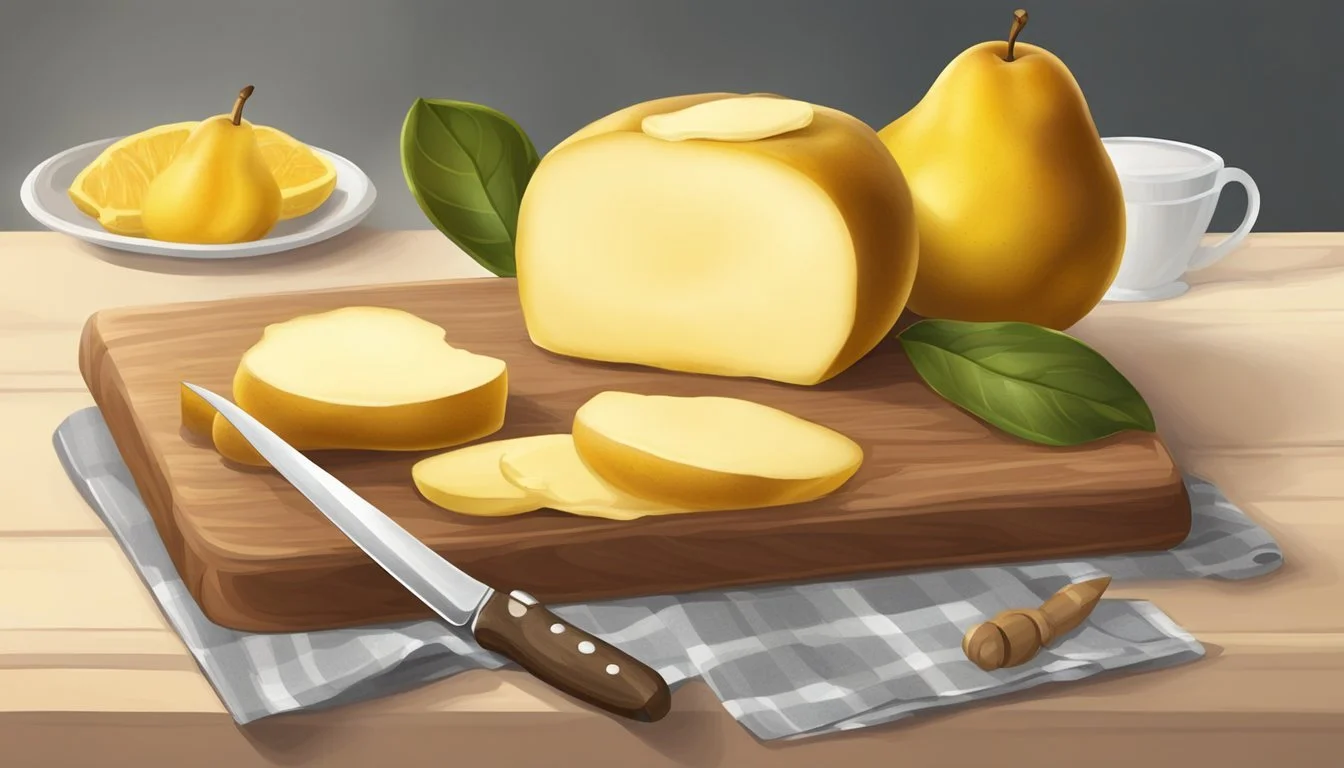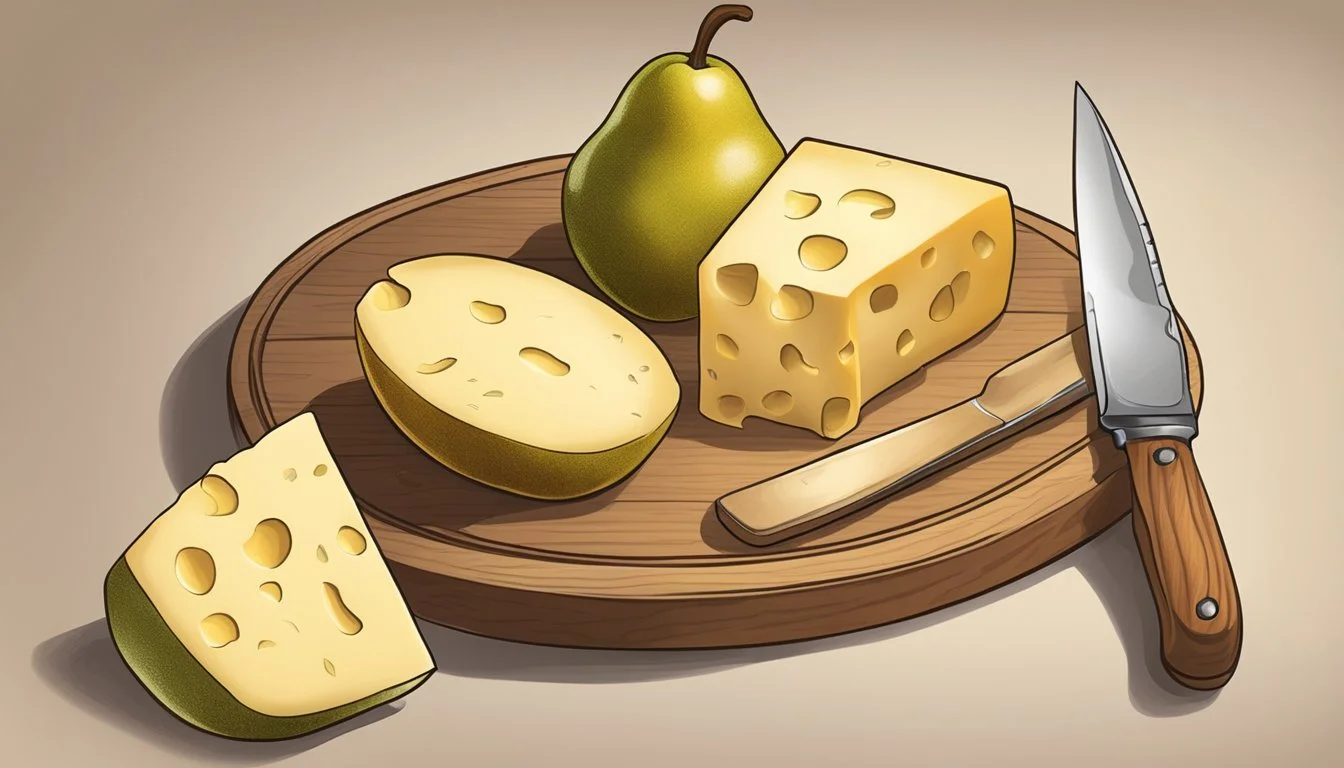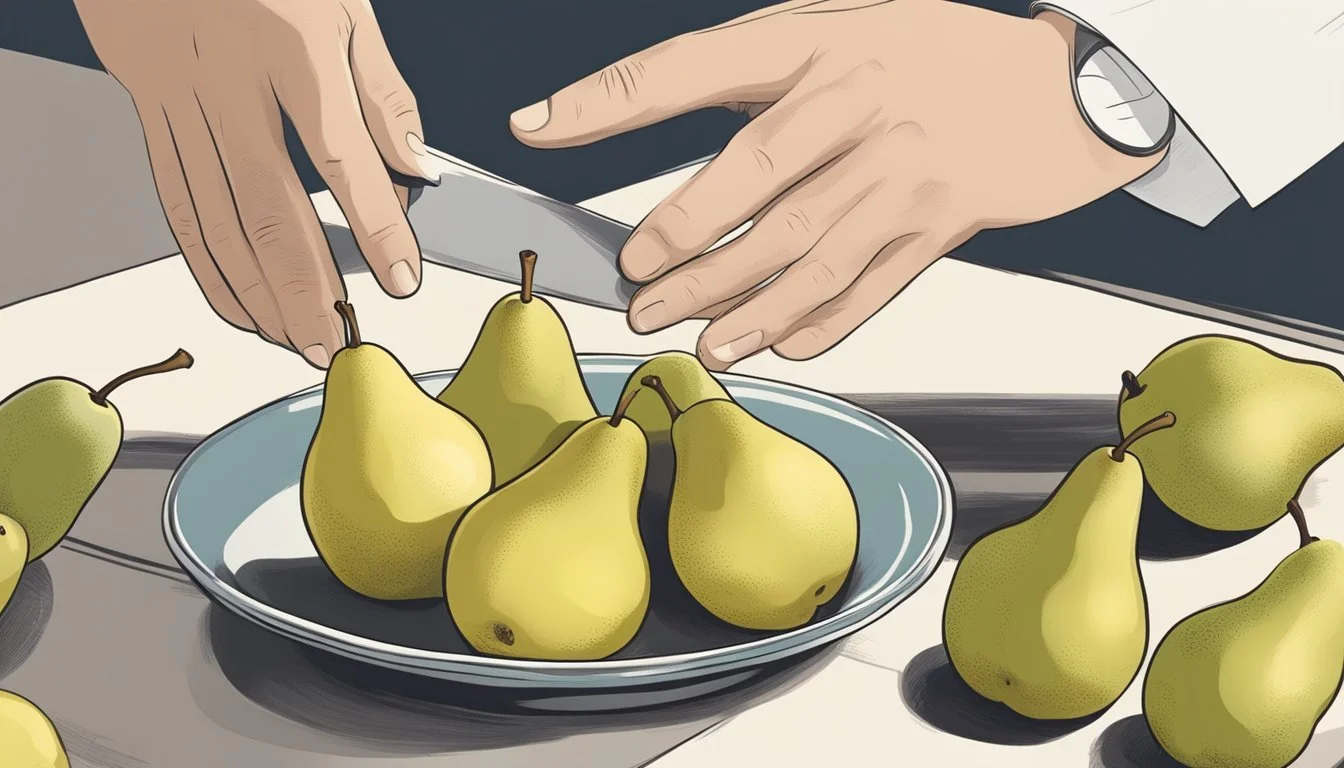How to Tell If French Butter Pears Are Ripe
Your Essential Ripeness Checklist
When it comes to enjoying French Butter pears, understanding the nuances of their ripeness is key to experiencing their full flavor and texture. These pears, recognized for their creamy texture and sweet taste, can often be mistaken for other varieties due to their similar appearance to Bosc pears, with a yellow-green color and a shape akin to D’Anjou pears. Originating from France, these pears carry their historical sophistication into today's kitchens. Identifying the perfect point in the ripening process enhances the enjoyment of French Butter pears, whether they are eaten fresh or used in recipes.
Knowing when a French Butter pear is ripe involves a few simple steps. Unlike some fruits that may be ready to eat as soon as they are picked, pears, including the French Butter variety, typically undergo a period of post-harvest ripening. A ripe French Butter pear exhibits a smooth, slightly glossy skin and may yield slightly to gentle pressure at its neck. The stem of a ripe pear is short and dark, possibly featuring a small brown cap. For those anticipating the enjoyment of these pears, storing them properly and understanding how to encourage ripening at home is essential.
Key Takeaways
French Butter pears are distinguished by a yellow-green color, creamy texture, and a short, stubby stem.
Proper pear ripeness can be assessed by a slight give at the neck and visual cues such as a smooth, slightly glossy surface.
To encourage ripening of these pears, store them with bananas or apples that emit ethylene gas, and store ripe pears in the refrigerator.
Identifying French Butter Pears
When selecting French Butter pears, one should focus on their distinctive characteristics that set them apart from other varieties. Recognizing these traits will aid in differentiating them and ensuring their proper ripeness for consumption.
Distinctive Characteristics of French Butter Pears
French Butter pears exhibit a teardrop shape with a rounded base that transitions into a short, straight neck. The surface is typically smooth with a light gloss, and the color palette ranges from yellow-green to a golden green-brown hue as they ripen. A key feature is the short, stubby stem, often dark and sometimes capped with a small, brown detail. The flesh of these pears is of notable importance; when ripe, it presents a firm, creamy, and juicy texture with a pale yellow to cream color. The sweetness of French Butter pears contributes to their desirability, offering a mellow flavor that enhances their buttery quality.
Comparing French Butter to Other Varieties
French Butter pears can be compared to the popular D'Anjou pear but differ mainly in their origins and texture. Below is a concise comparison:
Origins: French Butter pears herald from France, but they are now also grown in places like California and Oregon.
Texture: The texture is distinguished by its creamy and buttery feel, especially when ripe, in contrast to the typically firmer D'Anjou pears.
Shape: They share a similar teardrop shape with D'Anjou, but French Butter pears are known for their particularly smooth and sometimes russeted skin.
Taste: While both varieties are sweet, the French Butter pear has a more distinct, mellow sweetness that is often sought after for its subtle richness.
Stages of Ripeness
Identifying the exact stage of ripeness for French Butter pears involves visual inspection, tactile cues, and scent evaluation. Each stage—from tree to the table—has distinct characteristics.
From Tree to Table
French Butter pears are picked when they're mature but still firm. Maturation on the tree is crucial, but they reach optimal ripeness after they've been picked. Pears ripen from the inside out, so they're harvested when mature enough to ripen off the tree without becoming mushy.
Signs of Ripening Pears
The progression from firm to ripe French Butter pears involves several signs:
Color: A ripe French Butter pear will have a light to medium-yellow hue but should not have green spots.
Skin: The skin should remain smooth without wrinkles, which appear when overripe.
Firmness: Initially, the pears are quite firm to the touch. As they ripen, a slight softness can be felt, especially near the stem – known as the "neck test". If the pear yields slightly to pressure at the neck, it's an indication of ripeness.
Overripe Indicators
To avoid overripe pears, one should be mindful of these signs:
Softness: If the pear feels overly soft, particularly at the bottom, it has likely moved past the ideal ripeness.
Color: A dull, lifeless color can signal overripeness.
Skin: Wrinkled, shriveled skin is a clear indicator the pear is overripe and may have an inferior texture and flavor.
By understanding these stages, one can enjoy French Butter pears at their peak flavor and texture.
The Right Time to Pick
When harvesting French Butter Pears, one must take into account not only the season but also the specific techniques to determine the optimal time for picking.
Harvest Season
The ideal harvest season for French Butter Pears is in the early fall, as they reach maturity. However, maturity does not mean they're ripe and ready to eat immediately. These pears are known to ripen significantly post-harvest, so they are picked when mature but still firm.
Picking Techniques
The technique for assessing whether a French Butter Pear is ready to be picked involves a few tactile and visual cues:
Check the Neck: Apply gentle pressure to the neck of the pear, where the stem joins the fruit. If it yields slightly, the pear is ready to be picked.
Stem Flexibility: Observe the stem; if it separates easily from the tree when lifted and twisted gently, it's an indication that the pear is mature.
Color and Aroma: Although subtle, a mature French Butter Pear may exhibit a slight color change and emit a fruity aroma that indicates readiness for harvest.
By employing these methods, one can expertly select French Butter Pears at the right time for picking, balancing maturity and ripeness for the best quality fruit post-harvest.
Storing and Handling
Proper storage and handling are crucial for maintaining the quality of French Butter pears until they reach optimal ripeness. Incorrect practices can lead to premature ripening, or worse, spoilage and waste.
Short-Term Storage Tips
For pears that are to be consumed or used within a few days, short-term storage is key. One should store French Butter pears at room temperature until they reach the desired ripeness. The pears will ripen naturally at a moderate pace when left on the kitchen counter. However, to prevent bruising, they should not be stacked and should be handled with care. Ethylene gas naturally produced by pears will accelerate ripening, so to hasten the process, one can place the pears in a paper bag with ethylene-producing fruits like apples or bananas. This contained environment increases the concentration of ethylene gas around the pears, stimulating ripening.
Room Temperature: Place pears in a single layer to avoid bruising.
Paper Bag Method: To ripen faster, place in a paper bag with an apple or a banana.
Long-Term Preservation Strategies
When the intention is to keep pears for an extended period, one must employ long-term preservation strategies. Once ripened to the preferred level, French Butter pears should be moved to the refrigerator. This cooler environment slows down the ripening process, allowing the pears to remain in good condition for a longer time. They should be placed gently in the fridge to prevent bruising and stored at a temperature of 30 degrees Fahrenheit (approx. -1 degrees Celsius) to prolong their shelf-life while maintaining humidity levels between 85 to 90%. Under these conditions, they can last significantly longer.
Fridge Storage: Keep at 30°F (-1°C) and 85-90% humidity.
Prevent Bruising: Carefully place pears in the fridge, ensuring they're not under pressure from other items.
Enhancing Ripeness at Home
French Butter Pears, like many fruits, can be encouraged to ripen post-harvest. To ensure these pears reach peak ripeness, specific methods at home can be both effective and simple.
Using Ethylene to Ripen Pears
French Butter Pears naturally produce ethylene, a gas that stimulates ripening. By placing unripe pears in a confined space with ethylene-producing fruits, the ripening process accelerates. The most common ethylene producer to use is the banana.
Ethylene Ripening Method:
Place the unripe French Butter Pears in a fruit bowl with one or more bananas.
Optionally, confine them together in a paper bag to concentrate the ethylene gas.
Keep the environment at room temperature to facilitate the release of ethylene.
Checking for the Perfect Ripeness
To check if a French Butter Pear is ripe, one should focus on the neck, or the area near the stem. A ripe pear will yield slightly to pressure at the neck while remaining firm at the base.
Ripeness Test Criteria:
Texture: The neck should be slightly soft. If it's too hard, the pear needs more time; if too soft, it may be overripe.
Appearance: While the skin of a ripe pear may remain largely unchanged, a subtle change in skin color might occur, signaling readiness.
Pairing and Serving French Butter Pears
French Butter pears are known for their succulent, buttery flavor with a hint of lemon. They can enhance various dishes and serve as a delightful addition to a range of pairings.
Ideal Food Pairings
French Butter pears are exceptional in both sweet and savory dishes. Their creamy texture and distinct aroma complement a diversity of flavors and ingredients. Here are ideal food pairings to consider:
Cheese Boards: A classic pairing is cheese and pears. Pair them with soft cheeses like Camembert or Brie to bring out the floral notes of the pear.
Salads: Sliced French Butter pears add sweetness and texture to green salads, especially when combined with walnuts and a tangy vinaigrette.
Sweet Dishes: Their natural juiciness lends well to baked goods such as tarts and cakes, where they can be the central sweet element.
Creative Serving Suggestions
To maximize the enjoyment of French Butter pears, one can get creative with how they serve these fruits:
Poached Pears: Poach them in a syrup made with white wine and spices for an elegant dessert.
With Marinade: Use them in a marinade to add a sweet and fruity note to savory dishes, enhancing the overall flavor of the meal.
Grilled Pears: For a unique twist, grill the pears to caramelize their sugars and serve as an accompaniment to meats or as a dessert with a scoop of ice cream.
Cooking with French Butter Pears
When cooking with French Butter Pears, it's important to understand how their texture and flavor contribute to recipes. These pears are ideal for baking due to their creamy, buttery flesh, and can also be used in various pear-infused dishes.
Baking Essentials
French Butter Pears are a popular choice for baking because of their ability to retain shape and texture during the cooking process. When preparing a classic French pear cake, the pears should be peeled, cored, and diced into consistent pieces for even baking. Due to the pear's natural sweetness and juiciness, bakers can often reduce the added sugar or liquids in their recipes. Here's a basic process for preparing the pears for baking:
Peel the pear to remove the skin.
Core the pear to discard inedible parts.
Dice or slice as the recipe requires.
Pear-Infused Recipes
Aside from baking, French Butter Pears enhance the flavor of many recipes with their distinct pear flavor profile. One can incorporate them into sauces for savory dishes or simply poach them in wine or syrup for an elegant dessert. To use the pears in recipes, follow these steps:
Peel and cut the pears into desired shapes, such as wedges or chunks.
Simmer or poach them in a liquid, such as a spiced syrup, to infuse them with additional flavors.
Incorporate them into your recipe, such as a pear tart, ensuring even distribution for consistent flavor.
Preventing Pear Oxidation
To maintain the appearance of French Butter Pears in dishes, preventing oxidation is key. When pears are cut and exposed to air, they tend to oxidize, turning brown and losing aesthetic appeal. The use of lemon juice is a common method to preserve their color. Apply lemon juice to the cut surfaces of the pears to prevent browning. This simple step is crucial when presenting dishes where the appearance of the pear is important, such as in salads or as garnishes.
Health Benefits and Nutritional Info
French Butter pears are a variety of fruit known for their creamy texture and sweet flavor, characteristic of the fruit when fully ripe. Nutritional analysis shows that they are a valuable addition to a healthy diet, offering an array of vitamins, minerals, and dietary fiber.
Nutritional Properties:
Dietary Fiber: They are rich in fiber, which is essential for digestive health.
Vitamin C: A good source of vitamin C, important for maintaining a robust immune system and skin health.
Vitamin E: They contain vitamin E, which acts as an antioxidant, aiding in protecting cells from damage.
In addition to vitamins, French Butter pears offer essential minerals such as potassium, which is vital in maintaining healthy blood pressure levels, and a modest amount of copper, vital for iron absorption and the formation of red blood cells.
Health Benefits:
Digestive Health: The fiber content in pears contributes to regular bowel movements and aids in the prevention of constipation.
Antioxidant Activity: Presence of antioxidants helps combat oxidative stress and inflammation.
Immune Support: The vitamins found in these pears boost the immune system's capacities.
Nutrient: Calories
Amount per medium French Butter pear (approximate): 100
Nutrient: Total Fat
Amount per medium French Butter pear (approximate): 0.2 g
Nutrient: Dietary Fiber
Amount per medium French Butter pear (approximate): 6 g
Nutrient: Sugars
Amount per medium French Butter pear (approximate): 17 g
Nutrient: Protein
Amount per medium French Butter pear (approximate): 0.6 g
Nutrient: Vitamin C
Amount per medium French Butter pear (approximate): 7% of the Daily Value (DV)
Nutrient: Vitamin E
Amount per medium French Butter pear (approximate): 4% of the DV
Consumption of French Butter pears should be moderated if one is monitoring carbohydrate intake due to their sugar content. They can be included in a balanced diet, providing essential nutrients beneficial for one's overall health.
Selecting Pear Varieties for Different Uses
When choosing between pear varieties, it is crucial to consider the intended use, as some are better suited for fresh consumption while others excel when cooked or baked.
Best Varieties for Fresh Consumption
Anjou Pears, both green and red, are sought after for their juicy and smooth texture, making them a delightful choice for eating raw. The Comice Pear, often referred to as the Christmas pear, offers a buttery and rich flavor, ideal for a fresh fruit platter or as a luxurious addition to salads. Concorde Pears have a long, narrow shape and are known for their vanilla-sweet taste and crisp texture that hold up well when eaten fresh. For those preferring a smaller, sweeter bite, Seckel Pears are the perfect option with their exceptionally sweet flavor.
Anjou (Green & Red): Smooth, juicy.
Comice: Buttery, luxurious.
Concorde: Vanilla-sweet, crisp.
Seckel: Exceptionally sweet, small.
Recommended Varieties for Cooking and Baking
Bosc Pears stand out as a top choice for culinary uses due to their firm texture that withstands heat well, retaining its shape and flavor during cooking or baking. Another excellent choice for baking is the Asian Pear, which adds a firm texture and a sweet, watermelon-like flavor to dishes. Both of these varieties not only hold their texture but also absorb spices and syrups, enhancing the flavors of the recipe.
Bosc: Firm, retains shape.
Asian Pears: Firm, sweet & subtle.
These specifics about different pear varieties can guide chefs and home cooks alike in selecting the right type for their culinary creations or snacking preferences.









